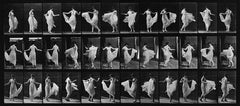
Animal Locomtion: Plate 659 (Mule) by Eadweard Muybridge
How about some tasty art history for a Tuesday segue? With today’s newsletter we tip our hats to a pioneering photographer, and owner of a peculiarly alternatively spelled first name: Eadweard Muybridge—on what would be his 189th birthday. To properly acknowledge the occasion, we reached out to Allison C. Meier, a brilliant writer, synergistic art thinker, and our Brooklyn neighbor to boot.
Meier’s musings have been published everywhere from The New York Times and Atlas Obscura to Smithsonian and Artsy. Our love story started with her writing at Hyperallergic, one of our regular internet haunts for insights into everything arts and culture. No matter where you read her work you’ll find she has a knack for making the historical relevant to our contemporary world, an infectious curiosity for oft-overlooked details, and an impressive fortitude for digging deep into the topic at hand. Her work is as riveting as it is historically rich. Read on! - Team 20x200
When in 1878 Eadweard Muybridge shared his photographs capturing the gallop of a horse—proving that all four hooves leave the ground when it gathers its legs under its body—the world was astounded by their innovation and art. Using tripwires and multiple cameras with the fastest shutter speeds available, Muybridge froze each stage of motion into a series that anticipated the film strip. The Philadelphia Photographer declared that “looking at them … is enough to turn your brain.”
The horses caused a sensation, and, indeed, remain Muybridge’s best-known work. (However, the oft-told tale of his experiment intending to settle a wager is widely regarded as more legend than truth.) The following year, Muybridge developed his zoopraxiscope, a cylindrical device that acted as an early motion picture projector, which animated these images on rotating discs. And the English-born photographer hardly stopped with horses. His animal locomotion studies, several of which are available in 20x200’s Vintage Editions, featured human bodies in all kinds of motion, running dogs and cats, soaring birds, and ambling elephants.
But where did he get an elephant? Supported by the University of Pennsylvania in the 1880s, Muybridge found plenty of muses at the Philadelphia Zoo (and a few human subjects among the Penn students). The university provided a huge outdoor studio where Muybridge innovated with dry plate technology and shutters released by electromagnets instead of by tripwire. Some of the results are beautiful, like Animal Locomotion: Plate 692 (Elk; trotting) with the elk’s incredible antlers in silhouette as it makes its long strides; others are uncomfortable, particularly the images of the disabled models he brought over from the Philadelphia Almshouse to study “abnormal movement.” Some seem to have no scientific purpose, such as the slow sway of the dancers in Animal Locomotion; Plate 197 (Couple Dancing), who twirl in front of the cameras.
Obtaining these shots was not always easy. The Philadelphia Press reported in 1885 that while Muybridge was attempting to capture the movement of two of the zoo’s lions, the animals "tore down the screen, to the unmitigated disgust of Mr. Muybridge." Sarah Gordon in the 2015 Indecent Exposures: Eadweard Muybridge's Animal Locomotion Nudes relates another incident in which a donkey sprinted from his elaborate photography set up and "Professor Muybridge nearly swore in exasperation." It could be just as unpleasant for the fauna, as Muybridge carried out cruel experiments, like startling chickens with explosives. One imagines the day documenting the glacial crawl in Animal Locomotion: Plate 750 (Sloth), with the creature’s movements barely registered in the series, was a relief to both Muybridge and his harried crew.
In 1887, he published 781 of these plates in Animal Locomotion: an Electro-Photographic Investigation of Connective Phases of Animal Movements. They ranged from very Victorian scenes like Animal Locomotion: Plate 38 (Woman Opening Parasol) to Animal Locomotion: Plate 659 (Mule) with the mule’s legs dynamically kicking up in the air. While the work had a major influence on the understanding of anatomical movement, it also rippled into the way bodies were depicted in art, such as Marcel Duchamp's 1912 Modernist watershed painting, Nude Descending a Staircase. In his thousands of images that froze in time what previously sped past the naked eye, Muybridge changed how people saw the world.
—Allison C. Meier
 About Our Guest Author
About Our Guest Author
Allison C. Meier is a Brooklyn-based writer on art, history, and culture. Previously she was senior editor at Atlas Obscura, and more recently a staff writer at Hyperallergic. She moonlights as a cemetery tour guide.















